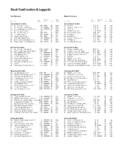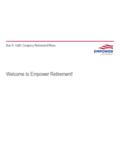Transcription of The Morningstar Category Classifications
1 The Morningstar Category Classifications (for portfolios available for sale in the United States) Morningstar Methodology Paper Effective June 30th, 2016 2016 Morningstar , Inc. All rights reserved. The information in this document is the property of Morningstar , Inc. Reproduction or transcription by any means, in whole or in part, without the prior written consent of Morningstar , Inc., is prohibited. The Morningstar Category Classifications | June 30, 2016 2016 Morningstar , Inc. All rights reserved. The information in this document is the property of Morningstar , Inc. Reproduction or transcription by any means, in whole or part, without the prior written consent of Morningstar , Inc., is prohibited. 2 Contents Category List 3 Introduction 7 Category Review Process 8 Changes 9 Equity 12 Sector Equity 16 Allocation 20 International Equity 27 Alternative 32 Commodities 38 Taxable Bond 40 Municipal Bond 46 Money Market 51 The Morningstar Category Classifications | June 30, 2016 2016 Morningstar , Inc.
2 All rights reserved. The information in this document is the property of Morningstar , Inc. Reproduction or transcription by any means, in whole or part, without the prior written consent of Morningstar , Inc., is prohibited. 3 Category List Category Group Category Name Equity Large Value 12 Equity Large Blend 12 Equity Large Growth 12 Equity Mid-Cap Value 13 Equity Mid-Cap Blend 13 Equity Mid-Cap Growth 13 Equity Small Value 14 Equity Small Blend 14 Equity Small Growth 14 Equity Leveraged Net Long 15 Sector Equity Communications 16 Sector Equity Consumer Cyclical 16 Sector Equity Consumer Defensive 16 Sector Equity Sector Equity Energy Limited Partnership Equity Energy 16 17 Sector Equity Equity Precious Metals 17 Sector Equity Financial 17 Sector Equity Global Real Estate 17 Sector Equity Health 18 Sector Equity Industrials 18 Sector Equity Infrastructure 18 Sector Equity Natural Resources 18 Sector Equity Real Estate 19 Sector Equity Technology 19 Sector Equity Utilities 19 Sector Equity Miscellaneous Sector 19 Allocation Allocation--15% to 30% Equity 20 Allocation Allocation--30% to 50% Equity 20 Allocation
3 Allocation--50% to 70% Equity 20 Allocation Allocation--70% to 85% Equity 20 Allocation Allocation--85%+ Equity 21 Allocation Convertibles 21 Allocation World Allocation 21 Allocation Tactical Allocation 22 Allocation Target-Date 2000-2010 22 Allocation Target-Date 2015 22 Allocation Target-Date 2020 23 The Morningstar Category Classifications | June 30, 2016 2016 Morningstar , Inc. All rights reserved. The information in this document is the property of Morningstar , Inc. Reproduction or transcription by any means, in whole or part, without the prior written consent of Morningstar , Inc., is prohibited. 4 Category List (continued) Category Group Category Name Allocation Target-Date 2025 23 Allocation Target-Date 2030 23 Allocation Target-Date 2035 24 Allocation Target-Date 2040 24 Allocation Target-Date 2045 24 Allocation Target-Date 2050 25 Allocation Target-Date 2055 25 Allocation Target-Date 2060+ 25 Allocation Target-Date Retirement 26 International Equity Foreign Large-Value 27 International Equity Foreign Large-Blend 27 International Equity Foreign Large-Growth 27 International Equity Foreign Small/Mid-Value 28 International Equity Foreign Small/Mid-Blend 28 International Equity Foreign Small/Mid-Growth 28 International Equity World Stock 29 International Equity Diversified Emerging Markets 29 International Equity Diversified Pacific/Asia 29 International Equity Miscellaneous Region 29 International Equity Europe Stock 30 International Equity Latin America Stock 30 International Equity Pacific/Asia ex-Japan Stock 30 International Equity
4 China Region 30 International Equity India Equity 31 International Equity Japan Stock 31 Alternative Bear Market 32 Alternative Multicurrency 32 Alternative Single Currency 32 Alternative Long-Short Credit 33 Alternative Long-Short Equity 33 Alternative Market Neutral 33 Alternative Multialternative 34 Alternative Managed Futures 34 Alternative Option Writing 34 Alternative Volatility 35 Alternative Trading--Leveraged Commodities 35 The Morningstar Category Classifications | June 30, 2016 2016 Morningstar , Inc. All rights reserved. The information in this document is the property of Morningstar , Inc. Reproduction or transcription by any means, in whole or part, without the prior written consent of Morningstar , Inc., is prohibited. 5 Category List (continued) Category Group Category Name Alternative Trading--Inverse Commodities 35 Alternative Trading--Leveraged Debt 36 Alternative Trading--Inverse Debt 36 Alternative Trading--Leveraged Equity 36 Alternative Trading--Inverse Equity 37 Alternative Trading--Miscellaneous 37 Commodities Commodities Agriculture 38 Commodities Commodities Broad Basket 38 Commodities Commodities Energy 38 Commodities Commodities Industrial Metals 38 Commodities Commodities Miscellaneous 39 Commodities Commodities Precious Metals 39 Taxable Bond Long Government 40 Taxable Bond Intermediate Government 40 Taxable Bond Short Government 41 Taxable Bond Inflation-Protected Bond 41 Taxable Bond Long-Term Bond 41 Taxable Bond Intermediate-Term Bond 42 Taxable Bond Short-Term Bond 42 Taxable Bond Ultrashort Bond 42 Taxable Bond Bank Loan 43 Taxable Bond Stable Value 43 Taxable Bond Corporate Bond 43 Taxable Bond Preferred Stock 43 Taxable Bond
5 High-Yield Bond 44 Taxable Bond Multisector Bond 44 Taxable Bond World Bond 44 Taxable Bond Emerging-Markets Bond 44 Taxable Bond Emerging-Markets Local-Currency Bond 45 Taxable Bond Nontraditional Bond 45 The Morningstar Category Classifications | June 30, 2016 2016 Morningstar , Inc. All rights reserved. The information in this document is the property of Morningstar , Inc. Reproduction or transcription by any means, in whole or part, without the prior written consent of Morningstar , Inc., is prohibited. 6 Category List (continued) Category Group Category Name Municipal Bond Muni National Long 46 Municipal Bond Muni National Intermediate 46 Municipal Bond Muni National Short 46 Municipal Bond High-Yield Muni 47 Municipal Bond Muni Single State Long 47 Municipal Bond Muni Single State Intermediate 47 Municipal Bond Muni Single State Short 47 Municipal Bond Muni California Long 48 Municipal Bond Muni California Intermediate 48 Municipal Bond Muni Massachusetts 48 Municipal Bond Muni Minnesota 48 Municipal Bond Muni New Jersey 49 Municipal Bond Muni New York Long 49 Municipal Bond Muni New York Intermediate 49 Municipal Bond Muni Ohio 49 Municipal Bond Muni Pennsylvania 50 Money Market Taxable Money Market 51 Money Market Tax-Free Money Market 51 Money Market Prime Money Market 51 The Morningstar Category Classifications | June 30, 2016 2016 Morningstar , Inc.
6 All rights reserved. The information in this document is the property of Morningstar , Inc. Reproduction or transcription by any means, in whole or part, without the prior written consent of Morningstar , Inc., is prohibited. 7 Introduction The Morningstar Category Classifications were introduced in 1996 to help investors make meaningful comparisons between mutual funds. Morningstar found that the investment objective listed in a fund s prospectus often did not adequately explain how the fund actually invested. For example, many funds claimed to be seeking growth, but some of those were investing in established blue-chip companies while others were investing in small-cap companies. The Morningstar Category Classifications solved this problem by breaking portfolios into peer groups based on their holdings. The categories help investors identify the top-performing funds, assess potential risk, and build well-diversified portfolios.
7 Morningstar regularly reviews the Category structure and the portfolios within each Category to ensure that the system meets the needs of investors. Morningstar assigns categories to all types of portfolios, such as mutual funds, variable annuities, and separate accounts. Portfolios are placed in a given Category based on their average holdings statistics over the past three years. Morningstar s editorial team also reviews and approves all Category assignments. If the portfolio is new and has no history, Morningstar estimates where it will fall before giving it a more permanent Category assignment. When necessary, Morningstar may change a Category assignment based on recent changes to the portfolio. The driving principles behind the classification system are as follows: Individual portfolios within a Category invest in similar types of securities and therefore share the same risk factors (for example, style risk, prepayment risk).
8 Individual portfolios within a Category can, in general, be expected to behave more similarly to one another than to portfolios outside the Category . The aggregate performance of different categories differs materially over time. Categories have enough constituents to form the basis for reasonable peer group comparisons. The distinctions between categories are meaningful to investors and assist in their pursuit of investing goals. In the United States, Morningstar supports 122 categories, which map into nine Category groups ( equity, sector equity, allocation, international equity, alternative, commodities, taxable bond, municipal bond, and money market). The Category group indexes and Category indexes listed with each Category are used in Morningstar s tools and reports to show performance relative to a benchmark. The Morningstar Category Classifications | June 30, 2016 2016 Morningstar , Inc. All rights reserved.
9 The information in this document is the property of Morningstar , Inc. Reproduction or transcription by any means, in whole or part, without the prior written consent of Morningstar , Inc., is prohibited. 8 Category Review Process Morningstar engages in a formal Category review process twice each year, in May and November; additional reviews for funds less than one year old are also conducted in February and August. The process begins with a quantitative filter that proposes Category recommendations based upon the three-year trailing portfolio statistics, which are calculated from an investment s reported holdings. There is a wealth of data used in this process, but the statistics examined coincide with the major portfolio components we use to define categories, such as asset allocation, market capitalization, value-growth score, and duration. The recommendations for changes to existing Category assignment are then reviewed by the Manager Research analysts who accept or reject the system s proposals.
10 Our research team uses a mosaic approach when performing our qualitative assignment. Their decision is based on many factors, including, but not limited to: familiarity with the strategy of the portfolio managers and fund family, their understanding of current market forces, an appreciation for alternative strategies which may not be borne out adequately in our statistical calculations, and a desire to portray the most accurate picture of economic exposure possible. After we propose a change to a fund s Category , we notify fund representatives for each investment. Category changes are sent to the fund s advisor with ample time to challenge our opinion, and provide contravening information in a Category appeal. Once an appeal is received the change is escalated and reviewed again by a second group of analysts. In addition to the formal review processes, we accept Category appeals throughout the year. Morningstar reviews all appeals, but generally rejects those that are based only upon a philosophical difference in the Category definition.






